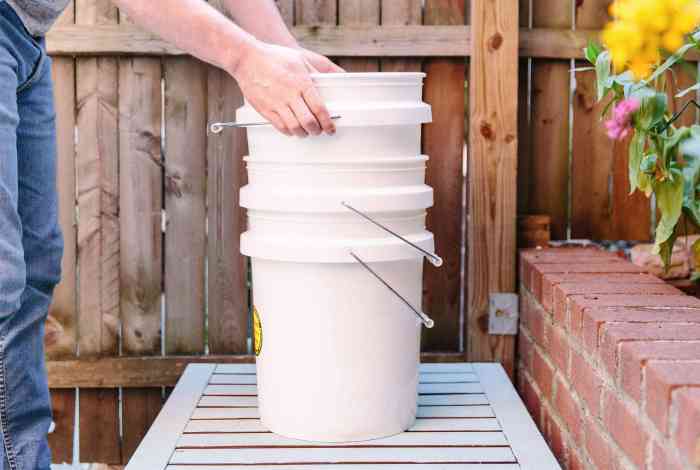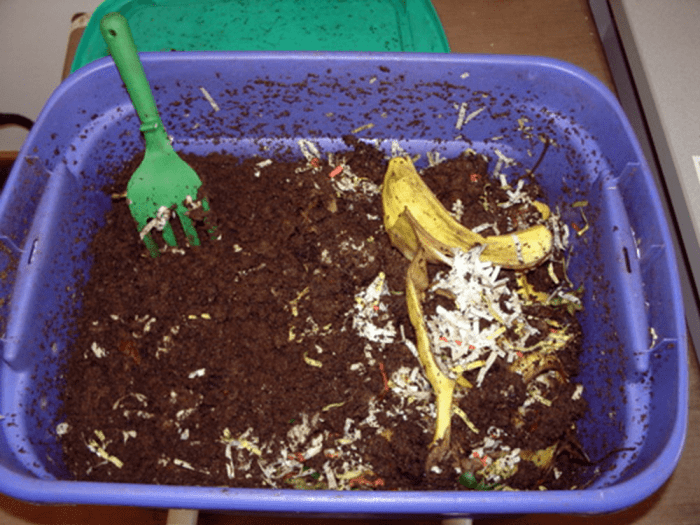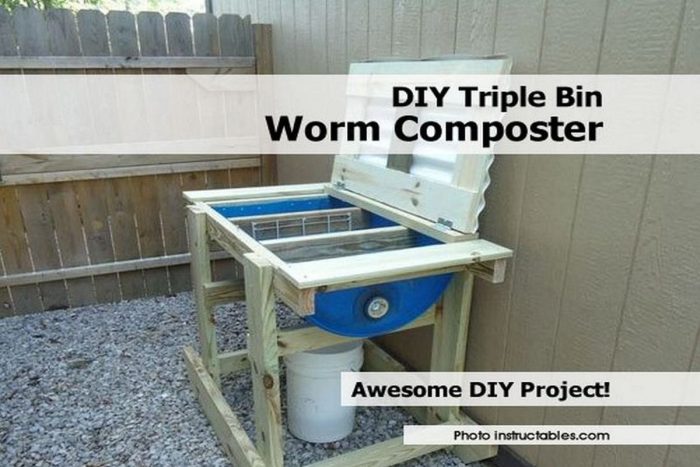DIY worm composter, also known as vermicomposting, is a fantastic way to transform kitchen scraps into nutrient-rich compost for your garden. This process involves using worms to break down organic waste, creating a valuable fertilizer known as worm castings. Not only does vermicomposting reduce your food waste, but it also provides a sustainable and eco-friendly way to improve your soil’s health.
The journey of vermicomposting begins with selecting the right worms, usually red wigglers or European night crawlers. These worms thrive in a controlled environment, consuming a variety of food scraps, such as fruit and vegetable peels, coffee grounds, and even shredded paper. By creating a comfortable and well-aerated bin, you can provide the perfect habitat for your worm colony to flourish.
Building a DIY Worm Bin

Building your own worm bin is a simple and rewarding project. You can create a composting system that’s both effective and affordable using readily available materials. This section will guide you through the process of constructing a DIY worm bin, from choosing the right materials to assembling a multi-tiered system for increased capacity.
Choosing Materials for a Worm Bin, Diy worm composter
The first step in building a DIY worm bin is selecting the right materials. There are many options available, and the best choice will depend on your budget, available space, and desired aesthetics.
Here are some common materials used for building worm bins:
- Plastic Storage Bins: These are readily available, affordable, and durable. Look for bins with tight-fitting lids to prevent moisture loss and odor escape.
- Wooden Planters: Wooden planters offer a natural aesthetic and can be customized to your liking. However, ensure the wood is untreated and safe for worms.
- Recycled Materials: You can repurpose various materials like old barrels, plastic tubs, or even a repurposed refrigerator. Make sure the material is clean, non-toxic, and has a secure lid.
Assembling a Simple Worm Bin
A simple worm bin can be constructed using a single plastic storage bin. Here’s a step-by-step guide:
- Choose a suitable bin: Select a bin with a capacity of at least 10 gallons. A larger bin will provide more space for the worms to thrive.
- Drill drainage holes: Drill several holes in the bottom of the bin for drainage. This will prevent the bin from becoming waterlogged.
- Add bedding: Line the bottom of the bin with a layer of bedding material. Shredded newspaper, coconut coir, or peat moss are suitable options.
- Introduce worms: Purchase a starter colony of red wiggler worms. These worms are known for their efficiency in composting.
- Add food scraps: Start adding small amounts of food scraps to the bin. Avoid acidic foods like citrus fruits and onions.
- Maintain moisture: Keep the bedding moist but not soggy. You can add water as needed.
- Monitor temperature: Worms thrive in temperatures between 55°F and 80°F. Keep the bin in a cool, shaded area.
Building a Multi-Tiered Worm Bin
A multi-tiered worm bin allows for increased composting capacity. You can create a vertical system using multiple bins stacked on top of each other.
- Prepare the bins: Choose multiple plastic storage bins of the same size. Drill drainage holes in the bottom of each bin.
- Create a drainage system: Connect the bins using PVC pipes or other drainage materials. This will allow excess water to drain from the top bin to the bottom bin.
- Add bedding and worms: Line each bin with bedding and introduce worms to each level.
- Feed and maintain: Add food scraps to each bin, ensuring proper moisture and temperature control.
A multi-tiered worm bin is a great option for those with limited space or who want to compost a larger volume of food scraps.
Harvesting Worm Castings: Diy Worm Composter

Worm castings, also known as vermicompost, are the rich, nutrient-packed waste produced by worms. These castings are a valuable fertilizer and soil amendment that can significantly improve the health and fertility of your garden. Harvesting worm castings is a rewarding step in the vermicomposting process, as it allows you to reap the benefits of your hard work.
Signs of a Healthy Worm Bin Ready for Harvesting
A healthy worm bin will display several signs that indicate it is ready for harvesting. These signs are a good indication that the worms have been diligently processing the organic material and producing a significant amount of worm castings.
- Abundant Castings: You will notice a significant amount of dark, crumbly castings throughout the bin. These castings will be distinct from the bedding material.
- Reduced Bedding: The amount of bedding material will have decreased noticeably as the worms consume it. This signifies that the worms have actively broken down the organic matter.
- Worm Activity: The worms will be actively moving and feeding, indicating a healthy and thriving population.
- Pleasant Odor: A healthy worm bin will have a pleasant, earthy odor. It should not have a strong, foul smell.
Separating Worm Castings from Bedding
Separating the worm castings from the bedding is a simple process that can be done using a variety of methods. The goal is to gently remove the castings while minimizing disruption to the worm colony.
- Sifting: This method involves using a sieve or mesh screen to separate the castings from the bedding. The castings will pass through the screen while the larger bedding material remains behind. You can use a variety of mesh sizes, depending on the size of your castings and bedding material.
- Hand Picking: This method involves manually picking out the castings from the bedding. This is a time-consuming method but can be effective for smaller batches of castings. It allows you to carefully select the best castings and avoid any contamination.
- Worm Tea: This method involves creating a liquid fertilizer from the worm castings. The castings are soaked in water for a few days, and the resulting liquid is used to fertilize plants. This method is a good way to utilize the nutrients in the castings without having to separate them from the bedding.
Storing and Using Worm Castings
Once you have harvested your worm castings, it is important to store them properly to maintain their quality. Worm castings can be stored in airtight containers in a cool, dry place. They can be used as a fertilizer for a variety of plants, both indoors and outdoors.
- Direct Application: Worm castings can be applied directly to the soil around plants. They can be sprinkled on the surface or mixed into the soil. The amount of castings used will depend on the type of plant and the soil’s nutrient levels.
- Compost Tea: Worm castings can be used to make compost tea, which is a liquid fertilizer that can be applied to plants through watering or foliar spraying. Compost tea is a good way to deliver nutrients to plants quickly and efficiently.
- Seed Starting: Worm castings can be used to start seeds. They provide a rich and fertile environment for seeds to germinate and grow. Mix castings with a seed starting mix or use them as a top dressing.
- Soil Amendment: Worm castings can be used to improve the structure and fertility of soil. They can be added to the soil before planting or mixed into existing soil. Worm castings help to improve drainage, aeration, and water retention, creating a healthier environment for plants.
Worm Composting for Different Needs

Worm composting, also known as vermicomposting, is a versatile method for diverting food scraps and other organic waste from landfills. With a bit of planning, you can customize your worm bin to suit your specific needs and lifestyle. Whether you live in a small apartment, have a large garden, or face cold weather conditions, there’s a worm composting solution for you.
Worm Composting for Apartment Dwellers
Apartment dwellers often face limited space and may not have access to a backyard. However, you can still successfully compost with worms using a compact worm bin. Here are some tips for creating a worm bin suitable for apartment living:
- Choose a Small Worm Bin: Opt for a bin that fits comfortably on a countertop, shelf, or under the sink. Many commercially available worm bins are designed for apartment dwellers and come in compact sizes.
- Use a Stackable System: Consider using a multi-tiered worm bin system. This allows you to expand your composting capacity as needed without taking up too much space.
- Minimize Odor: Choose a worm bin with a tight-fitting lid to prevent odors from escaping. You can also add a layer of shredded newspaper or cardboard to the top of the bin to absorb excess moisture and reduce odor.
- Choose the Right Worm Species: Red wiggler worms are a popular choice for apartment composting as they are hardy and can tolerate a wide range of temperatures.
- Monitor Moisture Levels: Keep the bedding in your worm bin moist but not soggy. Regularly check the moisture levels and adjust the amount of water added as needed.
Composting Larger Quantities of Food Scraps
For those with a large family or who produce a significant amount of food scraps, a multi-bin system is a practical option. This allows you to compost a larger volume of waste while still maintaining a healthy environment for your worms.
- Use Multiple Worm Bins: Start with two or three bins, and add more as needed. This allows you to rotate the bins, giving the worms time to process the food scraps in each bin before moving them to a new bin.
- Create a Cycle: Establish a cycle for your bins. For example, you could have one bin for active composting, one for resting, and one for harvesting worm castings.
- Maintain Proper Bedding: Ensure each bin has enough bedding material to support the worms. Use a combination of shredded newspaper, cardboard, and coconut coir for optimal results.
- Monitor Worm Population: Regularly check the worm population in each bin. If the worms seem overcrowded, consider dividing them into additional bins.
Worm Composting in Colder Climates
Worm composting can be successful in colder climates, but it requires some adjustments. Worms are cold-blooded creatures and become less active in cold temperatures.
- Insulate Your Worm Bin: Place your worm bin in a location that is protected from drafts and extreme temperatures. You can insulate the bin with blankets, bubble wrap, or styrofoam.
- Provide Heat: Consider using a heat mat or placing the worm bin near a heat source to maintain a comfortable temperature for the worms.
- Adjust Feeding: Reduce the amount of food scraps you add to the bin during colder months. Worms are less active and will not process food as quickly.
- Monitor Moisture: Pay close attention to the moisture levels in the bedding during colder months. The bedding may dry out more quickly due to lower temperatures.
- Consider Indoor Composting: If you live in a very cold climate, you may want to consider bringing your worm bin indoors during the winter months.
Worm Composting with Limited Sunlight
While worms don’t require direct sunlight, they do need some light for optimal health. If you have limited sunlight in your home, you can still successfully compost with worms.
- Place the Worm Bin in a Well-Lit Area: Find a spot in your home that receives indirect sunlight, such as near a window.
- Use Artificial Light: If you have very limited natural light, you can supplement with artificial light. A simple desk lamp or grow light can provide enough light for your worms.
- Monitor Worm Activity: Observe your worms to ensure they are active and healthy. If they seem sluggish or inactive, consider adjusting the lighting or providing additional food scraps.
Resources and Further Information
Worm composting is a rewarding and enriching experience, and there’s always more to learn. This section will guide you to additional resources and encourage you to share your own experiences.
Reputable Online Resources
These websites provide comprehensive information on worm composting, from basic techniques to advanced practices:
- Worm Composting Guide: This website offers a detailed guide on worm composting, covering everything from bin construction to troubleshooting. It also includes a helpful FAQ section.
- The Worm Castings Company: This website provides information on worm composting, vermicomposting, and worm castings. It also offers a wide range of worm composting products.
- University of Vermont Extension: The University of Vermont Extension offers a wealth of information on worm composting, including research findings and best practices.
Local Worm Composting Groups and Workshops
Connecting with local worm composting enthusiasts can be a valuable resource.
- Local Gardening Clubs: Many gardening clubs offer workshops or meetups on worm composting. Check with your local gardening club or search online for “worm composting groups” in your area.
- Community Centers and Libraries: Community centers and libraries often host workshops and events on sustainable living, including worm composting.
- Online Forums and Social Media Groups: Join online forums and social media groups dedicated to worm composting. These groups provide a platform for sharing experiences, tips, and troubleshooting advice.
Sharing Your Experiences
Your experiences with DIY worm composting can benefit others.
“Share your successes, challenges, and tips with the community. Help others learn from your journey!”
- Online Forums and Social Media: Share your worm composting adventures on online forums, social media groups, or blogs.
- Local Events: Consider presenting a workshop or talk on worm composting at local community events or gardening clubs.
With a little patience and care, you can easily establish a thriving worm composting system in your home. As you watch your worms diligently break down your kitchen scraps, you’ll be amazed by the transformation. Not only will you be reducing your environmental impact, but you’ll also be creating a valuable resource for your garden. So, embrace the world of vermicomposting and experience the rewarding benefits of this sustainable and rewarding practice.
Building a DIY worm composter is a great way to turn food scraps into nutrient-rich fertilizer. While the process is relatively simple, you might find yourself needing to cut some pieces of metal for the construction. If you’re looking to take on a more advanced project, consider building a DIY plasma table, like the one featured here.
A plasma table would allow you to cut metal with precision, which could be useful for future DIY projects, including building a more elaborate worm composter.
